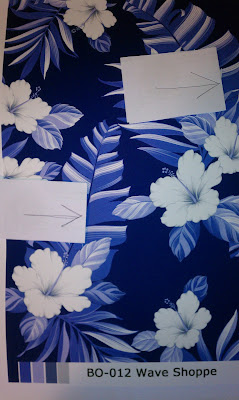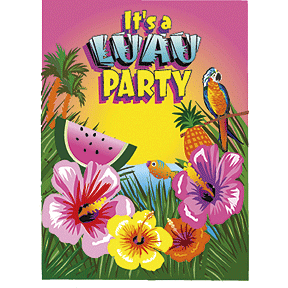 |
| Sketch 1 |
Near the end of the of the year we thought we would close things out with a glimpse of one of the new Hawaiian print fabrics we have been working on for the last 4 months.
Of course there are those of you that are already asking the big question "what takes you so long to knock out a design?" So for those people I will also guide you through some of the basic steps in doing so.
The first step in this process is taking my thoughts on a new fabric design and conveying those mental thoughts to the artist.
This particular design started out with a few leaf and flower pictures from Google images that I simply laid out on a table so I could get a feel for the sizing and repeat for the design.
Once I have a feel for the general repeat I take some rough measurements of things such as flower size, leaf width etc. I will then send my masterpiece to our artist via email. Once she recovers she will call me back and pick my brain over the phone, eventually we reach a point where she feels comfortable enough to start roughing out the first draft of this particular design. Shown in Sketch 1 is the first draft sketch with hibiscus flower and banana leaf.
The first step in this process is taking my thoughts on a new fabric design and conveying those mental thoughts to the artist.
This particular design started out with a few leaf and flower pictures from Google images that I simply laid out on a table so I could get a feel for the sizing and repeat for the design.
Once I have a feel for the general repeat I take some rough measurements of things such as flower size, leaf width etc. I will then send my masterpiece to our artist via email. Once she recovers she will call me back and pick my brain over the phone, eventually we reach a point where she feels comfortable enough to start roughing out the first draft of this particular design. Shown in Sketch 1 is the first draft sketch with hibiscus flower and banana leaf.
After we received the first sketch we put it into triage and discuss
the designs good and bad points and note any changes we would like to see. In this
particular rendition we decided that the banana leaf was to dominant as well as
to wide.
So the decision was made to scrap one of the banana leafs and replace it
with a fern leaf, which is depicted in sketch 2.
At this point I should mention that one of the specs for this design was that it not only had to work for Hawaiian shirts for men and women, but also muumuus and dresses.
One item that troubled us on this design was that the overall design looked a little “heavy”, meaning the overall design was just to dominant and out of balance with the background color. The weight of a design can make or beak things so its imperative that this part is done correctly.
This
particular design was actually passed between quite a few artists in Hawaii as well as Japan to discuss the weighting of the leaves as well how to improve the overall look and feel of the design. In my professional opinion the finalized design is now perfectly weighted and well balanced.
If you look over at sketch 2 you will see that the tip of the fern leaf is pretty tight against the tip of the banana leaf and the leaf for the hibiscus flower overlaps the banana leaf.
 |
| Colorized sketch |
At first glance you want the eye to see the entire design and not jump to a specific part, which is this situation we felt we had created just that. If you look at the colorized sketch you will see a few portions of the banana leaf that stood out too much against the rest of the leaf design.
Rather than trying to describe this over the phone it's way easier to send the artist a marked up picture.
In this particular round of changes we asked the artist to break up the broader parts of some leaves with some simple strokes of a brush. The end result was a night and day difference.
Now take a look at the coloring mockup below and you will see that not only has the space between the foliage been increased, but also the width of the banana leafs has now been decreased. The overall positions of the flower clusters were also tweaked so they were in balance with the overall repeat.
Now take a look at the coloring mockup below and you will see that not only has the space between the foliage been increased, but also the width of the banana leafs has now been decreased. The overall positions of the flower clusters were also tweaked so they were in balance with the overall repeat.
Next
is the all-important task of coloring the design. During the early stages of the design the
artist will slap on some random colors, mainly so we can have a little better
perspective on what the end design will look like.
Ultimately the color choices
are left up to me, so during the often lengthy in-between time that it takes to make sketch changes, I can be found digging through color
charts and pairing up colors that I feel will be well received by our
in-store and on-line customers.
I will normally lay out 50 color codes on a table, and through a process of elimination, eventually arrive at five colors (for each colorway) that I feel go together the best.
I will normally lay out 50 color codes on a table, and through a process of elimination, eventually arrive at five colors (for each colorway) that I feel go together the best.
I would eventually settle on a series of colors, add them in print
order next to the color mockup, take a picture of it and then send it to the artist.
Yes it’s a bit primitive sounding, but that’s how it works and I am probably being more technical than most artists.
The
end result of all of this work is a new design in blue (shown on the left),
which has a perfect color balance. Men as well as women should embrace the
colors and how well they work with this particular design.
 |
| New blue |
The new purple shown below is another design that we are very excited about.
Currently there is not a lot of purple Hawaiian fabric on the market and the designs you can buy are really sucky and cheap looking.
While we have not yet received the strikeoffs, which is essentially a very short run of approximately 3 yards or each color, we anticipate some really stellar looking fabric. Especially the purple Hawaiian fabric.
 |
| New purple |
Which is where we make our Wave Shoppe labeled dresses and Hawaiian shirts sold on www.waveshoppe.com
Your comments and opinions matter, what do you think overall of these designs? Would you buy a shirt or dress in this design?
















